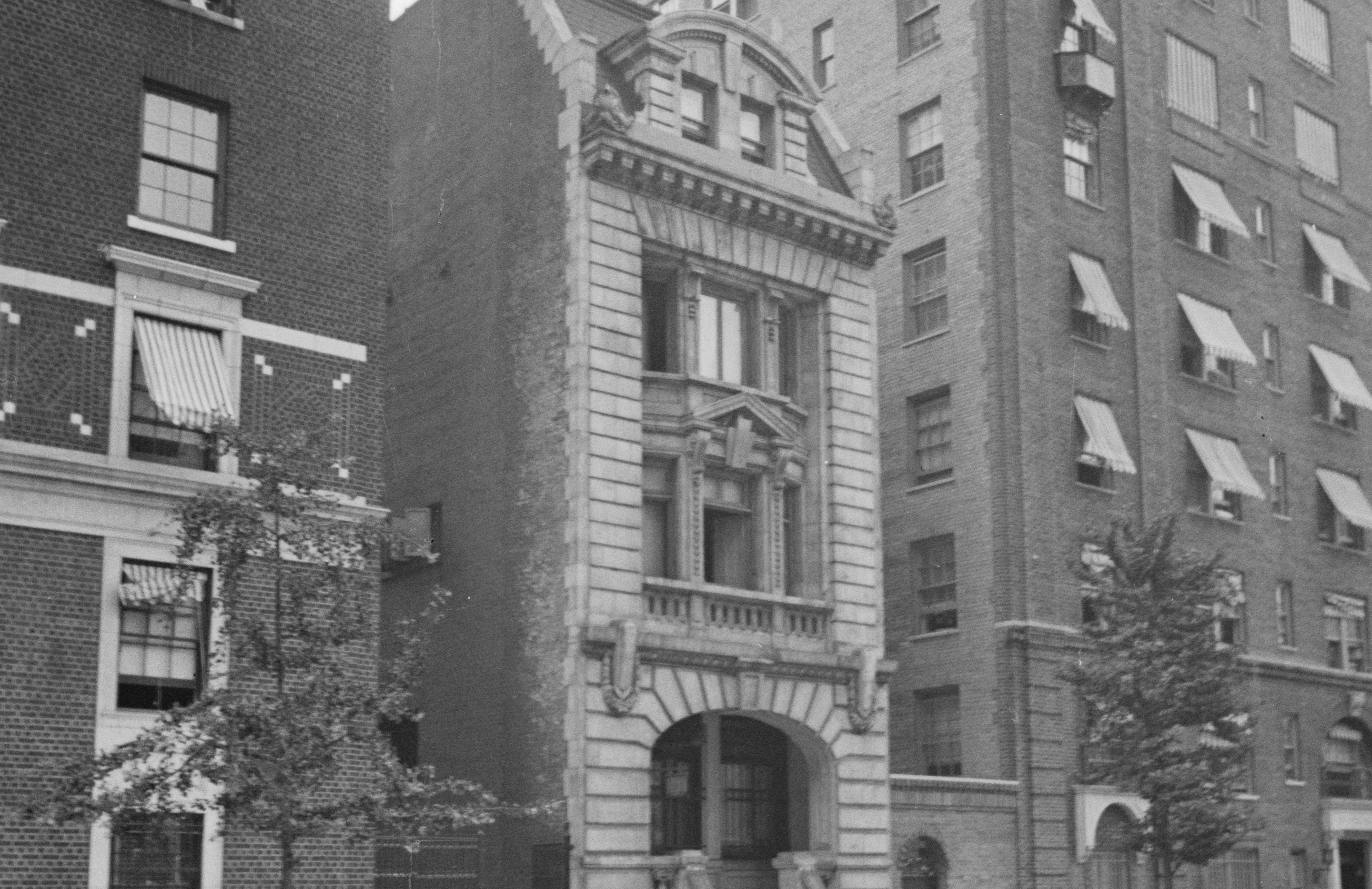
Abraham Erlanger House-232 West End Avenue
by Tom Miller
In 1887 as the Upper West Side saw a flurry of development, Forrest Lawther moved into his new home at 232 West End Avenue. The wide townhouse, designed by E. L. Angell, intended for a financially comfortable family like the Lawthers.
By the turn of the century, William Henry Oakley was living here. Oakley, who owned a dry goods store at 224 Church Street, lived here with his wife and daughter, Grace. The family spent their summers in their country estate in Minerva, New York.
Tragedy came for Mrs. Oakley in 1901. Her 78-year old half-brother, David F. Butcher, had been wealthy – having gone into the soap business and earning “a considerable fortune,” according to The New York Times. Butcher lost everything, however, in the Financial Panic of 1873, after which “the old man had done little or nothing.”
Retiring into a hermit-like existence, the old man lived in three rooms on the top floor of a tenement building at 544 West 45th Street. Mrs. Oakley visited once a week to bring him money.
In December 1901, the neighborhood boys were annoying Butcher as they always did, making their way to the tin-covered roof of the building and jumping on it. This time when the aged man tried to chase them off, he lost his footing and fell down the stairs to his death.
Three years later, in 1904 the Oakley family moved to 203 West 70th Street, selling the West End Avenue house to Abraham Erlanger. Erlanger was one of the foremost theatrical producers and managers in the East Coast – President of the New York Theatre Company, Klaw & Erlanger Amusement Co., Klaw & Erlanger New Orleans Theatres Co.; Treasurer of the Hayman Davies Company; Secretary of the Nixon & Zimmerman Amusement Co.; and Director of the Interstate Amusement Company.
The next morning the couple closed the house and sailed for Europe for a break.
Erlanger apparently felt that the twenty-year old house needed its own dramatization, for he commissioned Herts & Tallant to redesign the house.
The façade transformed into a Beaux Arts beauty more expected on the opposite side of Central Park. Above the dramatic, spilling staircase, the architects provided a grand arch with an inset entrance. The rustication of the limestone continued from sidewalk to the mansard roof, interrupted only by the grand Beaux Arts windows of the second and third stories.
Among the early social functions in the newly redesigned home was the marriage of Erlanger’s sister, Sophie, on October 28, 1907. That same year Mrs. Erlanger was busy with a series of informal “at homes” from 2:00 to 5:00.
The year 1909 was a socially busy one in the Erlanger house. Mrs. Jacob Litt was a houseguest for several months that year and the Erlangers gave a series of dinner parties while she was there. The last of the series was a dinner for ten on March 5. The next morning the couple closed the house and sailed for Europe for a break.
Change was happening along West End Avenue at the time. In November 1915, The Edison Monthly noted, “As far as West End Avenue is concerned, the transition began about 1900. Up to that time the street had met the gaze of a long standing respectability behind a front of brown stone broken at intervals by the marble or granite of sanatorium or private school.”
“Within a year, to the comment of all passers,” said the magazine, “four corner houses in the lower eighties submitted soberly to the wrecking process and within five years many of the corner and most desirable lots throughout the section were occupied by 100 x 100 twelve-story apartment houses, built of terra-cotta and limestone.”
As the row houses of West End Avenue replaced by modern apartment buildings, however, the house at No. 232 remained.
The widowed Abraham Erlanger died on the morning of March 7, 1930. His fortune estimated to be within the broad range of $2.5 to $75 million. His will split the estate among his brother, former Supreme Court Justice Mitchell L. Erlanger, and his two sisters.
Then scandal reared its head.
The scandal arrived with a name: Charlotte M. Fixel. Miss Fixel, an actress, insisted that she was Erlanger’s common-law wife and that she even picked out the clothes he bought. In Surrogate O’Brien’s courtroom on November 26, 1931, former actress Dorothy Stoy McCullough testified that Erlanger died in Fixel’s arms.
“Charlotte had her arms about his shoulders; she was crying bitterly and kept begging him to speak to her,” she said.
John J. Dillon, however, chief executive of the Erlanger Theatrical enterprises said that Erlanger’s wife had personally read letters from him to Fixel, in which he “explained that his interest in her was only platonic and based on his admiration for her devotion to his employer.”
The tangled legal web went on for days.
Then scandal reared its head.
Three years later, on March 24, 1939, the Erlanger estate leased the empty house. The New York Times gave the disappointing news that it “will be altered and operated as a rooming house.”
At the time, Nelson Landsale was on the editorial staff of Newsweek magazine, where he became its art and music editor. After a brief move to South America, the writer returned to New York, turning to full time free-lance writing. He purchased No. 232 West End Avenue, returning it to a private residence.
While living here Landsale wrote for slick, high-end publications such as Art in America, The Review, Town & Country, Promenade, Horizon, House & Garden, This Week, and Ford Times. The 49-year old journalist died in the house in November 1964.
In 1966 criminal lawyer, Henry Rothblatt, annoyed because his East Side landlord had raised his rent from $800 to $1000 a month, purchased the Erlanger house for $75,000. Rothblatt put another $60,000 into renovations and updating.
Then in 1989, the house became home to the Hineni Heritage Center. The center includes a multimedia museum, Torah studies and a singles program. Levine Builders who thankfully respected the historic façade did renovations to the exterior. Inside, not so much.
Despite the Edison Monthly’s 1915 observation that West End Avenue was being “apartmentized,” the house at No. 232 still stands. In addition, like so many of Abraham Erlanger’s productions, the Beaux Arts façade—a rarity in Upper West Side residential architecture—is a crowd pleaser.
Tom Miller is a social historian and blogger at https://daytoninmanhattan.blogspot.com/


